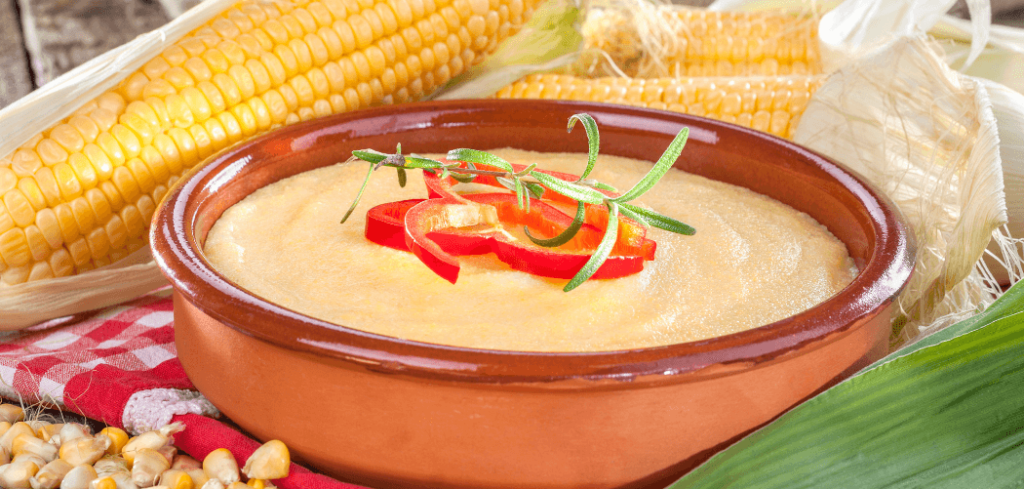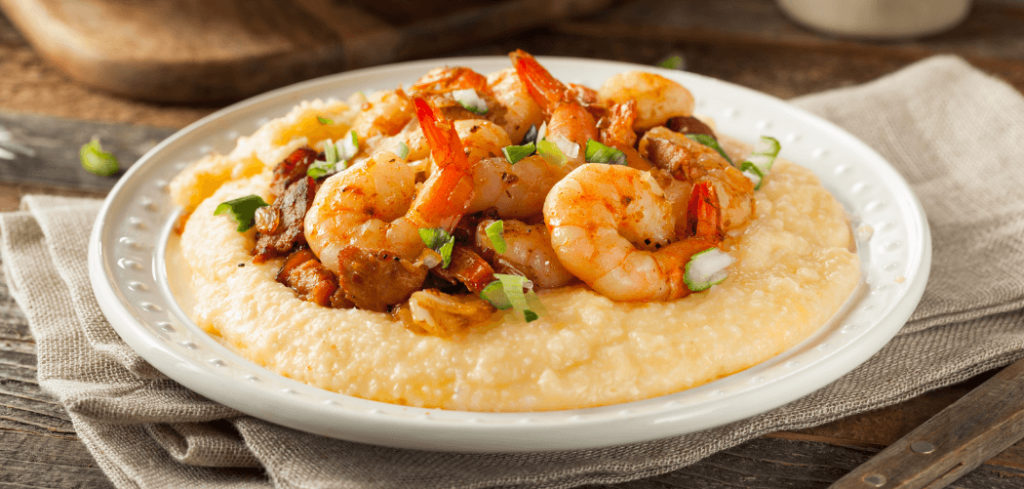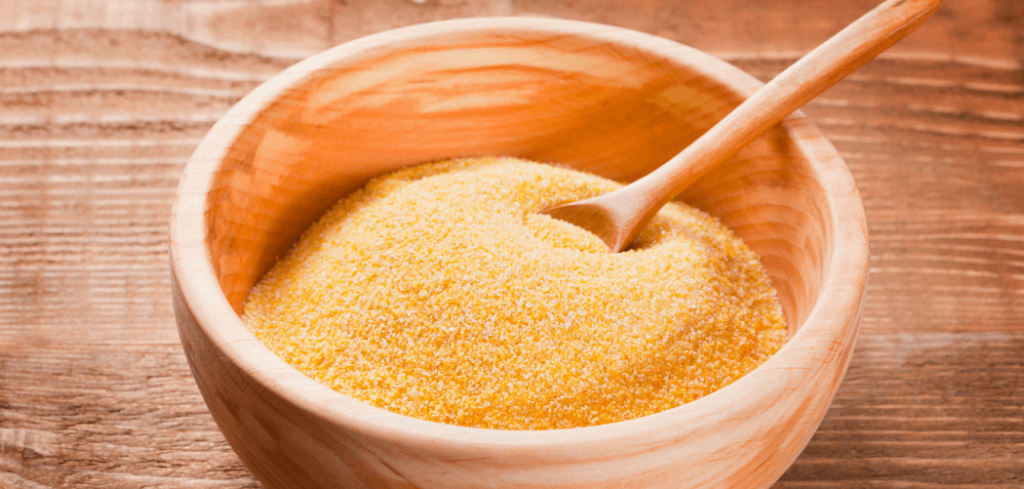Grits are a traditional breakfast food in the southern states. They are often compared to oatmeal in terms of nutritional value. The gluten-free community has expressed worry about the safety of grits. Ground maize is used to make the traditional kind of grits.
Gluten-free status is warranted since maize does not contain any of the protein Celiacs and gluten sensitivity sufferers may consume corn grits without worry. Dent maize is used to make grits because its kernels are softer and stretchier than other corn types.
After the outer husk is removed and dried, the seeds are crushed into smaller pieces. A southern breakfast staple that is gaining traction outside of its traditional strongholds. You don’t have to eat grits for breakfast.
Grits are an excellent choice for lunch or dinner if you’re looking for something heavy and satisfying. It’s hard to believe, but cornmeal is grit’s primary ingredient. Hominy is pounded and dried to make grits. In maize, hominy is the kernels on the inside.
Grits may be made in various ways, but the most typical method is to boil them and mix them with butter and milk. However, this Southern classic is often “dressed up” with various cheeses, spices, sauces, meats, shellfish, and vegetables. Grits are gluten-free since they are not manufactured from grain, barley, or rye.
Because of cross-contamination, many popular brands of spirits are not gluten-free. It would help if you scrutinized the labels before purchasing. Grits aren’t suitable for those on the ketogenic diet since maize is a fantastic source of carbs.
Grits: A Brief History

Grits have their origins in the cuisine of the American Indians. Corn was ground into a mush by the Native Americans. The Old English term “grit,” which implies coarse meal, is the source of the name “grits.”
There were a lot of grist mills in the South that made grits and cornmeal from locally produced corn, but they’ve all but disappeared.
The maize was ground using stones and water-powered mills. Aside from their nutritious qualities,
grits became a mainstay of southern cuisine due to their low cost and ease of preparation.
Indeed, the expression “Nose to the Grindstone” was coined in response to a similar working method. Because stone grinding creates a lot of heat and may fry the corn, the sense of smell needed to be employed to supervise the operation closely.
How to Serve Grits
It is possible to prepare grits in various ways, from sweet to savoury. However, you may utilise them as a starting point for other items, such as protein and vegetables. A few of the most popular additions include cheese, milk, and scallions or green onions.
Grits may be topped with a variety of protein options. Shrimp is perhaps the most popular. Ham, seafood, eggs, grillades (made from round steak), shredded beef or pig, and beans are all acceptable protein sources.
The use of various kinds of vegetables as garnishes is also common. Collard greens, spinach, mushrooms, entire corn kernels, okra, and peppers are among the most common vegetable toppings. Sweet grits, a grain choice for gluten-free diets, are delicious and may offer diversity to your breakfasts.
Poached or sautéed pears, apples, or peaches with toasted almonds or coconut may be a delicious topping for these muffins. Butter and honey are traditional additions.
Here Are The Few Kinds Of Grits That Exist
1. Whole dry kernels are pulverized in a gristmill between the stones. They’re more often than not speckled and have a more robust taste of maize. Making grits the old-fashioned way.
2. Hominy grits differ from stone-ground grits in that the hull and germ are removed from the kernels before they are processed.
3. Quick grits are finely powdered and prepared to be cooked in a short period.
4. Precooked and dehydrated, these grits are ready to eat with a simple addition of boiling water.
What Are Grits Made Off?

Grits are prepared from ground corn, generally from dent corn, a less sweet, starchy kind of corn. Yellow or white grits are occasionally referred to as such because of the color of the maize used in their production.
Grits have a moderate flavor and are a good canvas for other tastes since they are neutral. Grits manufactured from yellow corn have a more distinct taste, whereas white grits have a more delicate, subtle flavor since they are processed with the germ intact.
These seeds are highly sought to retain the taste and color of heirloom types while still allowing for grinding to a medium or coarse consistency. Grits that take less time to cook and have a milder flavor are quick-cooking or instant grits.
Are Grits Healthy?
Additionally, grits are a good source of B vitamins, including thiamine, niacin, riboflavin, and folate, which may either be found in the kernel or put back in after processing. Biochemical processes and energy levels may be maintained with the aid of B vitamins.
As eye-healthy antioxidants, grits are also high in lutein and zeaxanthin. There are no added calories or fat in plain grits since they are naturally minimal in both. Most people eat regular and quick grits that have been processed rather than stone-ground varieties with all the benefits of whole grain.
There is less fiber and nutrition in their diets as a result. Each serving of instant grits made with water has 2 grams of fiber and 3 grams of protein. To put it way, cooked oatmeal offers four grams of fiber and six grams of protein per cup.
With only one serving, you get the required daily amount of iron for your body. Enriched grits to get the most absorption from plant-based iron eat them with fruit first thing in the morning. Vitamin C aids absorption. Nerves are packed with nutrients, and consuming them may positively impact one’s health.
So yes, Grits are healthy for you.
Are Grits Gluten-Free?
Manufacturers of gluten-free grits take precautions to avoid cross-contamination since spirits are inherently gluten-free. Unfortunately, one of the most widely available grits brands does not meet these requirements.
Just as you would with any other grain you buy at the supermarket, you should always check the label to make sure the product is gluten-free. The Celiac Disease Foundation says that cross-contamination is always possible when food is packed or processed and comes into touch with other gluten grains or substances.
A gluten-free label on the container is your best bet for confirming that the item you’re buying is free of allergen. If the product has fewer than 20 parts per million of gluten (ppm), it’s regarded as safe for gluten-intolerant or sensitive persons.
Are Grits Good For You?
Grits have a few health advantages:
Various nutrients are found in grits, including vitamins, minerals, and antioxidants.
Lowered Heart Disease, Diabetes Type II and Some Cancers Risks
Grits are a good source of antioxidants, which may help protect cells from the harmful effects of free radicals, unstable atoms in the human body.
The health of the Eyes
Grits are rich in antioxidants demonstrated to enhance vision and eye health and protect against age-related eye ailments. It’s essential to keep in mind that lutein is quickly dissolved and hence lost in the heat of cooking. Grits lose some of their lutein content when they are fried.
Reduced Possibility of Anaemia
Anemia caused by iron deficiency is more frequent in elderly individuals. Thus, eating foods like grits may help prevent this condition. Folate deficiency may lead to anemia. Therefore, it’s good to have a lot of it.
10% of the daily iron intake may be found in a single serving of stone-ground grits. They’re also a great source of B vitamins, including the B complex.
Gluten-free food that is safe to eat.
In wheat, barley, spelled, and rye, a family of proteins known as gluten, may be discovered, among others. Gluten-free meals are generally safe for most individuals to consume. In contrast, symptoms such as bloating, constipation, diarrhea, and stomach discomfort may occur in those with celiac disease or non-celiac gluten sensitivity.
Grits are inherently gluten-free, making them a good carb option for those who must avoid this family of proteins. For celiac or gluten-sensitive, it’s always best to check the label for any possible gluten contamination. It’s not uncommon for maize to be processed alongside gluten-based goods.
Also Read This: Ballerina Tea Health Benefits, Side Effects, Weight Loss, Facts & More
How To Make Gluten-Free Grits At Home?

You can prepare it at home to ensure that it is entirely gluten-free, although some brands may have been contaminated during manufacturing. A gluten-free diet necessitates improvisation on many occasions. As long as you prepare ahead, you may still enjoy many of your favorite foods and flavors. This recipe, which calls for gluten-free grits, is a delicious way to eat them:
Ingredients
Amaranth, 1 cup
One clove of finely chopped or crushed garlic
One finely diced medium onion
3 quarts of water or vegetable stock
Soy sauce is an Asian condiment (season to taste)
Salt from the sea (season to taste)
Sauces with a high heat level (season to taste, optional)
2-tomatoes cut into small pieces (for garnish, optional)
Directions
In a 2-quart pot, add the vegetable stock. Toss in the amanita, onion, and garlic.
A boil should be reached before the heat is reduced. Cook for 20 minutes with the lid on, or until the stock has been absorbed to the desired consistency.
Crunchy, not hard, amaranth is what you want. A mild boil for 30 seconds is all that is needed if it is still too watery or undercooked.
Soy sauce and salt to taste. Garnish with tomatoes and a few drops of spicy sauce, if preferred.
Brands Offering Gluten-Free Grits
1. Arrowhead Mills – Arrowhead Mills Organic Gluten-Free Yellow Corn Grits are a nutritious and delicious way to start your day. All-natural grits with no added sugar or salt made from organic yellow maize. Certified gluten-free. Their all-purpose flour is gluten-free certified and has 13 grams of whole grain per serving, making it a healthier alternative.
2. Bob’s Red Mill – Bob’s Red Mill Gluten-Free Yellow Maize Polenta is crafted with only the best golden corn to ensure that your taste buds are satisfied. It’s a porridge prepared from coarsely crushed maize that’s been simmered in water.
To serve as a warm corn side dish, top with a little more butter and salt. Bob’s Red Mill Gluten Free Maize Grits Polenta is creamy and excellent in savory or sweet recipes, prepared from the finest golden corn for a rich taste that will satisfy your palette.
3. Julia’s Pantry – Organic steel-cut gluten-free grits are produced and processed by Julia’s. According to the company, its goods are tested regularly to fulfill regulatory requirements.
4. Palmetto Farms – Grits made by this company are stone milled to preserve the natural oils found in maize grains. Grits from Palmetto are a gluten-free standard because of traditional processes. It is produced at a facility that does not use wheat and is thus naturally gluten-free. Since 1934, Palmetto Farms has been grinding grits in this facility.
5. Old School – Old School Mill uses only the highest-quality, genuine vintage ingredients to create the products you love. David Hinson repurposed the milling equipment from a 1954 Meadow’s Mills Meal Monster for many years to build his milling operation.
6. Dixie Lily – Cooked in three to five minutes, Dixie Lily White Corn Grits resemble traditional grits. (Approx.) In this product, all components are farmed in the United States. This product is free of gluten.
7. Carolina Grits – Many varieties of gluten-free grits are available from Carolina Grits, a North Carolina firm. White, yellow, and blue spirits are all available for purchase and consumption. Cornmeal and other corn-based goods are also available.
8. Anson Mills – Three of our best-performing and most tasty grains go into making Anson Mills Gluten-Free Flour. With a finely milled combination of Carolina Gold Rice Flour (45%), 18th Century Style Rustic Toasted Oat Flour (45%), and New Crop Heirloom Bennecake Flour (10%), this flour may be used in batters, pan slices of bread, flatbreads, and skillet loaves of bread. This mix has no synthetic components of any type.
Gluten-Free Tips For Preparing Grits
Additionally, grits may be prepared in only a few minutes. The most straightforward technique of preparation resembles the process of preparing brown rice. If your nerves came in a packet that included a recipe, give it a go.
A big pot with 4 to 5 times the amount of water as grits should be used to cook your grits. For example, you’ll need four to five cups of water to make one cup of grits. Use less water if you want your determinations to have a drier texture.
You’ll need around 45 minutes of cooking time for the water to boil before you can start stirring it and making sure the bottom doesn’t burn. Add butter and salt to taste after the grits have reached the desired doneness for you.
Tips For Making Gluten-Free Grits Are Also Included Here

1. The grits won’t be able to absorb any additional salt after they’ve been cooked, so always add salt to the water before cooking.
2. Cooking grits should be whisked often (nearly continuously) for the smoothest, creamiest texture possible.
3. Adding grated or shredded cheese to your grits may enhance their taste and creamy texture. However, while choosing cheese, be on the lookout for gluten-containing components.
4. Because grits absorb lighter liquids such as water, broth, and milk more easily than cream, you should add it at the very end to smooth out the texture if using cream.
5. The kind of grits you have will determine how long it takes to cook; traditional nerves take around 10 minutes, whereas quick grits cook in about 5 minutes.
6. Stone ground grits may be made creamy with minimum stirring using a slow cooker.
Related: What is Winter Melon? – Winter Melon for Digestion, Weight Loss & More
Drawbacks
Grits have several advantages, but they also have several drawbacks.
In the first place, “rapid,” “regular,” or “immediate” varieties are made by removing the outer peel and germ of the corn kernel (embryo) . The starchy endosperm is now all that’s left. Because the pericarp and germ are the most nutrient-dense parts of the corn kernel, the rapid, regular, or immediate types lack the complete nutritional profile of the stone-ground kinds.
There is less fiber in processed grits than in whole corn kernels since the pericarp has been removed. Fiber may be found in the pericarp. Several health advantages of fiber, an indigestible carbohydrate, have been shown, including better digestion, reduced cholesterol levels, a greater sense of fullness, and even weight reduction.
Even though stone-ground variants are a more healthful alternative, they are more challenging to acquire in grocery shops outside the South. Because grits are usually served with high-calorie foods like milk and butter and cheese and syrups and bacon and fried catfish, they have another drawback.
The use of high-calorie meals regularly may contribute to weight gain and health problems associated with obesity, such as heart disease.
Old fashioned grits
In a grist mill, entire dry corn kernels are crushed between two stones to make stone-ground grits. Stone-ground grits have a speckled look, a more chewy texture, and a richer corn taste since the whole kernel, including the germ, is pulverized.
Ingredients:
2 quarts of fluid
2 cups of milk
2/3 cup coarsely ground cornmeal
a pinch of pepper and a bit of salt
14 cup heavy cream
2 tbsp. of melted butter
Instructions:
1. Simmer the milk and water in a medium-sized pot.
2. Stir in water to cover and let grits sit for a few minutes until chaff is visible on top.
3. Drain the grits using a fine mesh strainer after skimming the top to remove the trash.
4. Cook the grits in the simmering liquid for about 20 minutes, often stirring, until they reach the desired consistency.
5. Salt and pepper to taste, then add the heavy cream and butter, as well as salt and pepper if needed.
6. Allow cooling completely before serving.
Difference Between White And Yellow Grits

Grass grits are available in two distinct colors: white and yellow. There is no discernible difference in texture between the two, and the two may be used interchangeably in recipes, although there are some nutritional distinctions between the two. As a starting point, the color of grits is determined by the corn kernels ground up to form them.
White grits are prepared from white corn, whereas yellow grits are derived from yellow corn. There is just a little difference in flavor between the two. While the white type has a more robust flavor, the yellow variant offers a subtle sense of sweetness that their white counterparts do not have.
White grits are softer than black grits. I’ve discovered that adding butter to white grits makes them taste better. Grits with a higher starch concentration than white have more sugar than those with a higher starch content, such as yellow grits. Even so, it might be difficult to tell the two apart.
Following your understanding of the distinctions (or lack thereof) between the two different varieties of grits, let’s discuss some of the fantastic things you can do with them.
As previously said, grits are a typical appearance on breakfast dishes in the southern United States. They pair nicely with breakfast foods like eggs, bacon, and sausage. They are also a good match for a variety of seafood dishes.
The Shrimp, as mentioned above, and Grits is perhaps the most well-known grits-related meal, but it also pairs nicely with salmon and catfish dishes. There are also Charleston-style grits cooked in milk rather than water and are served with fried chicken. Grits made in this manner are creamier than regular grits.
Besides that, a few more colors are being experimented with by specific individuals. Grits such as blue and purple grits are manufactured from blue corn, which is also used to make the blue corn chips that are now all the rage in restaurants.
Grits are a simple dish to make if you’ve never tried them before. To get started, just follow these easy steps. Whether they’re white or yellow, you’ll receive an unmistakable dose of Southern heritage with every purchase.
DISCLOSURE
Please Be Aware: Statements in this article is certainly not meant to address, cure, treat or even identify any disease or either been evaluated by the Food and Drug Administration. Instead, it is only for informational reasons that it is composed.
Please, you should see your doctor or a certified medical practitioner for those who have any health problem in any respect before taking any supplement you find here or elsewhere.
 | Fitweightlogy’s content writers’ team constantly contributes to writing high-quality content linked with all the best products associated with weight loss, healthy lifestyle, fitness, tips, and motivation. Furthermore, provide tips on beauty and nutrition. |
Related Articles
- Purple Potatoes – This Carb Bursts With Antioxidants, and It Is Healthy – How To Maximize Its Versatility?
- What Are The Natural Health Benefits Of Cucumbers? How To Add Cucumber To Your Diet?
- Turmeric (Curcuma Sativa) – What Are The Natural Health Benefits of Turmeric? How To Use It?
- Hormonal Belly: Why Do We Get It? – Is Hormonal Imbalance Responsible For Belly Fat?
- Benefits of Dong Quai – Does This Ancient Chinese Remedy Make You Gain Weight?
Posted in
Welcome to Fitweightlogy! We are an optimum review website of all the best products associated with weight loss, healthy life, fitness, tips, and motivations. We are a quickly developing organisation given that we typically put our visitors first. A customer-focused experience has regularly been our objective, and we value our comprehensive policies, which have placed us in a domain well beyond our competitors. On this website, we assist our visitors in reaching their desired weight, appearance goals and live a healthy lifestyle, as well as save money and time by meticulously researching and evaluating the market, assessing the available products, and producing informative recommendations based on factors such as quality, availability, price and more. Furthermore, our passion is to assist you in choosing the best possible product through our product reviews.








